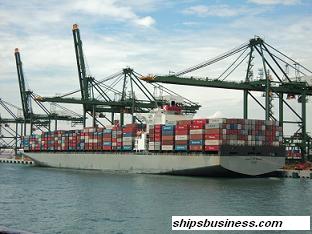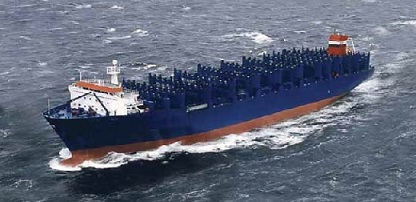
Fig :Container ship loaded condition
Container Liner Trade
Due to the nature of container transportation (goods arriving for loading in sealed containers etc.), it is common practice that:
- The Chief Officer is not requested to sign Mate’s Receipts
- The Master is not requested to sign Bs/L.
However, the Owners remain responsible for the cargo as per manifest for the time same is on board. In order to avoid claims and enable the Owners to repudiate potential claims, the ship’s Officers must ensure that:
- During loading, all loaded containers are properly sealed.
- The containers are in apparent good condition without holes or serious damages.
- Cargo stowed into special containers (open top, open sides, flat tracks or over length 45 feet, etc.) is properly stowed and secured.
- Reefer containers are in good condition, functioning properly and the temperature is as per relevant instructions.
In case of any deviation from the above, the Line Servants (Agents, Stevedores, Planners etc.) must be immediately notified in writing advising them to remedy as necessary or in case this is not feasible, shipment must be rejected.
Containers and cargo insurance
In principle, cargo insurance only covers claims relating to material damage to goods.
Exceptionally, the proprietor's interest in the container as packaging may also be insured if a special agreement is reached or through inclusion thereof in the damage liability invoice value. Interest in a leased container is not in principle insured.
The purpose of packaging is to allow transport of goods and to protect them from possible damage. If the above aim has been fulfilled, it is most common for only the packaging to be damaged, and not the goods.
If the packaging does not have any separate, intrinsic value, no independent loss may occur. Packing paper, which is discarded after the arrival of the cargo and suffers wear during transport, cannot therefore form the basis of a claim for damages. If the goods have reached their destination, the only relevant question is whether the goods have suffered loss and not whether the packaging is damaged. This also applies to cases.
Consideration can only be given to any such claim if the goods have depreciated in value solely as a result of the damage to the packaging. This is the case for example with preserved foods and certain branded goods. Another example is cement, which retains its normal commercial value only in its original bags. If cement which is in itself sound is sold in unmarked bags because the original bags have been damaged, it automatically suffers depreciation. In such cases, compensation may be paid despite the damage being limited to the bags.
Otherwise, compensation may only be paid for packaging damage if a separate value is assigned to the packaging either in the policy or in the invoice (e.g. barrels or containers). This only applies if the packaging is expected to have a longer service life than the duration of one transport operation.
A different matter entirely is the cost of repairing or replacing packaging, if this has to be performed en route. It may be possible to claim compensation for these costs, though not in the form of packaging losses but as loss minimization costs, which are expended to return the goods to a transportable state and to prevent losses on the remaining insured journey. For such a claim to be allowable, the packaging must have been satisfactory at the start of the journey. If the journey is complete or the remainder of the journey is uninsured, the insurer will not meet such costs, because, the insurance contract having expired, no more insured losses can be incurred.
Because of the uncertainties involved in using cargo insurance to insure a container as packaging, it is better to provide separate hull insurance by way of special conditions for container insurance. As far as the proprietor's interest is concerned, double insurance cover may then be provided by the cargo insurance and the container & hull insurance.
Multi-purpose ships may carry containers and general cargo. These ships can be cellular
container ships with a stiffened tanktop with the ability to ‘stopper’ (block) cell guides.
Sometimes owners wish to carry bulk or general cargoes in container ships. A ship which is
classed as a container ship will not have been assessed for this type of loading, nor will the
inner bottom, hatch covers, loading manual, Cargo Securing Manual and ISM certification
have been approved for the carriage of these cargoes. Before general cargo can safely be
carried on a container ship certification as a general cargo ship is necessary. The club has
published an edition of Standard Cargo on the subject of container ships and general cargo.
Summarized below are some basic container transport procedures. These procedures are only indicative, not exhaustive in nature and one must always be guided by practices of good seamanship.
Safe cargo stowage and planningWhen considering acceptability of a container cargo stowage plan, some basic check items, procedures / guidelines concerning cargo stowage shall be taken into account .
Read
more...
Safe Cargo operation On Arrival Port, Prior Commencing Cargo Operation
1) The composition of cargo watch personnel shall be decided and duties well understood.
2) All personnel involved in the cargo watch shall be briefed regarding the expected operations and provided with a Cargo Discharge Plan
.
Read more...
Cargo cranes operation, maintenance & safety matters
Guidelines and procedures concerning containership hull strength & stability When considering acceptability of a container cargo stowage plan, the following procedures/guidelines concerning hull strength & stability shall be taken into account:
a) Draft, Trim and Heel Draft restrictions at berth, approaches, passage and next port shall be taken into consideration and vessels maximum draft must be maintained within the applicable restriction.
Read more...
Procedures for dangerous cargo handling and documentation
Handling dangerous cargo requires special care due to the inherent hazardous nature of the cargo and applicable carriage regulations.
Read more...
Procedures for reefer cargo handling
Reefer containers require special care after they are loaded on board ship. These containers need to be supplied with power, monitored closely for proper function and repaired as required in case of malfunction.
Read more...
Handling breakbulk,Out of gauge and open top containers
Break bulk cargo is usually stowed on flat racks and platforms. It is important to confirm that the break bulk cargo itself is properly secured onto the Flat rack or Platform prior loading on board.
Read more...
Containership operation: 2 in 1 (Two in One) Loading
The term 2 in 1 operation is normally used when two 20feet units are loaded in one 40feet bay underdeck. When such loading operation is being conducted, it must be ensured that the terminal staff is aware of the vessels lashing system.
Read more...
Containership operation: On Deck Loading of 20feet Containers
20feet containers loaded on deck must be spaced apart in order to leave room for lashing each container on the fore and aft ends.
Read more...
Containership operation: Opening closing hatch covers
Hatch cover operations are frequently carried out on board container ships but due care is necessary to prevent damage by incorrect operation.
Read more...
Containership operation: Cargo lashing
Regular inspection and maintenance of ships cargo securing devices must be carried out. These would include routine visual examination of components being utilized, lubrication of securing devices, repair of damaged securing devices and separating out and rejecting damaged/unusable securing devices.
Read more...
Containership Cargo securing
When containers are carried on deck, the ship is required to be approved for that purpose and the containers themselves are secured with twistlocks and lashings. These usually consist of steel rods and turnbuckles.
Read more...
Containership Cargo Securing Devices (Lashing Gear Box Containers) Vessel shall account for all lashing gear box containers including bins prior departure from every port.
Read more...
Containership Cargo hold ventilation
Cargo holds of container ships are fitted with two basic types of ventilation systems, namely natural and mechanical. Mechanical ventilation could be of either the supply or the exhaust type.
Read more...
Safety navigation for container ships While planning the passage for intended voyage the safety of navigation should be accommodated in, where it is both reasonable and possible to do so,
Read more...
Containership Cargo care at sea
Condition of Cargo (Container) Securing / Lashing shall be checked at least once daily and tightened as required.
Read more...
Containership operation: Safety of personnel On board containerships there are several potential safety hazards in the cargo working area and these will have to be identified, made safe and monitored to ensure continued safety.
Read more...
Containership operation: wet damage in cargo hold Water entered into vessel cargo holds may cause wet damage to the cargo inside containers especially stowed on the bottom, unless the bilge water is drained in a proper and swift manner.
Read more...
Containership operation: hull damage stevedores In case a third party including stevedores is responsible for an accident caused by work, such as Cargo handling, Bunkering, or Loading ships stores or the like, the Master shall handle the accident with appropriate steps to claim for damages.
Read more...
Measures to protect the vessel side against stevedores injury All working areas and accesses must be checked to be clear of any slippery matter and obstructions, be structurally sound and well lit, before stevedores come on board.
Read more...
Measures to protect reefer cargo deterioration
Check and monitor each reefer container as per voyage instruction, which requires some basic check items.
Read more...
Containership Navigation : Ships motion in a seaway Ships are affected by movement in six degrees of freedom; rolling, pitching, heaving, swaying, surging and yawing. Of these, rolling, pitching and heaving generate the highest forces during heavy weather.
Read more...
Containership Cargo Securing Arrangement Details of the securing system and its constraints are set out in the vessels approved Cargo/Container Securing Manual.
Read more...
Containership Cargo Operation : Common reasons for stowfall Container stows often fail due to:
Container stacks being too heavy and too high overall, exposing the lower containers to excessive transverse racking and compressive forces due to the tipping effect.
Read more...
Containership operation : Ships motion in a seaway :parametric roll
The term parametric roll is used to describe the phenomenon of large unstable roll motion suddenly occurring in head or stern seas.
Read more...
 Other info pages !
Ships Charterparties
Other info pages !
Ships Charterparties Related terms & guideline
Stevedores injury How to prevent injury onboard
Environmental issues How to prevent marine pollution
Cargo & Ballast Handling Safety Guideline
Reefer cargo handling Troubleshoot and countermeasures
DG cargo handling Procedures & Guidelines
Safety in engine room Standard procedures
Questions from user and feedback Read our knowledgebase
Home page
 ShipsBusiness.com is merely an informational site about various aspects of ships operation,maintenance procedure,
prevention of pollution and many safety guideline. The procedures explained here are only indicative,
not exhaustive in nature and one must always be guided by practices of good seamanship.
ShipsBusiness.com is merely an informational site about various aspects of ships operation,maintenance procedure,
prevention of pollution and many safety guideline. The procedures explained here are only indicative,
not exhaustive in nature and one must always be guided by practices of good seamanship.
User feedback is
important to update our database. For any comment or suggestions please Contact us
Site Use and Privacy - Read our privacy policy and site use information.
//Home //Terms and conditions of use
Copyright © 2015 www.shipsbusiness.com All rights reserved.


